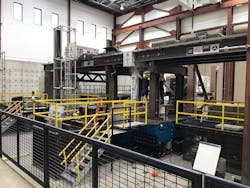Combined accelerated bridge construction methods were determined to be safe and ready for real-world application following tests using massive shake tables at the University of Nevada, Reno’s world-renowned Earthquake Engineering Laboratory.
The tests in April subjected a 70-ton, two-span, 70-ft-long bridge to multiple earthquake simulations of an approximate magnitude of 7.5. The hydraulically driven tables, programmed to mimic the forces of an earthquake, tested six different kinds of bridge connections integrated into a single bridge. Each individual connection had been previously tested on its own at the University of Nevada, Reno.
Together, the team of College of Engineering doctoral fellows, doctoral candidates, graduate and undergraduate assistants were looking for two specific outcomes: of the six connections, four were designed to be undamaged, even during strong earthquakes, and two were designed to undertake a controlled amount of damage to serve as a fuse, to absorb the forces of the earthquake by breaking.
“Along with avoiding collapse, the outcome of our study showed that all of the six connections performed as expected,” said Saiid Saiidi, principal investigator of the project, professor in civil and environmental engineering at the University and director of the Center for Advanced Technology in Bridges and Infrastructure, in a release. “It will be a few months before we can evaluate data from the 280 sensors that we had in the bridge to get more insight about the connections—including transducers, accelerometers, potentiometers, string potentiometers and strain gauges all to record the forces the connections experienced—but we are now confident to recommend these connections for application in real bridges.”
The shake-tables started with movements at 150% of the simulated earthquake magnitude, and each subsequent test ramped-up the movement by 25%. The simulated earthquake mimicked the large ground motions of the deadly and damaging 1994 Northridge, Calif., earthquake. Ultimately, the goal was to prove the connections were ready to be a part of the expedited bridge construction techniques and help provide earthquake safeguards.
The study was part of the University Transportation Center on Accelerated Bridge Construction project known as ABC-UTC, which is funded by the United States Department of Transportation. The Transportation Center is led by Florida International University in collaboration with the University of Nevada, Reno and Iowa State University.
The specific mission of ABC-UTC-Seismic, the project being led by the University of Nevada, Reno, is to develop earthquake-resistant precast bridge components and systems, and transform research data into seismic design guidelines to help expand the utilization of accelerated bridge construction methods in moderate and high seismic zones.
---------
Source: University of Nevada, Reno



